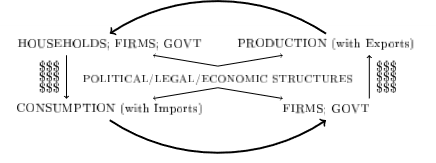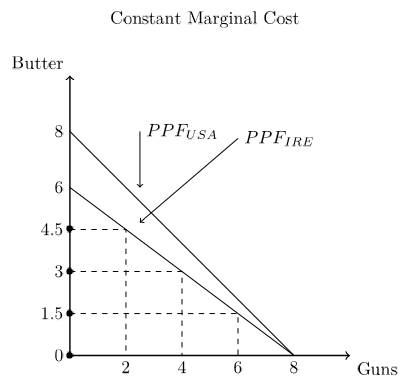ECON 251-H Midterm 1 Study Guide
YARBROUGH CHAPTERS
Chapter 1
Economics concerns itself with understanding how people, firms, governments, and economic systems react to changes.
What does microeconomics do?
analyze economic choices and outcomes at the sub-national, firm, and/or individual levels
What are some subfields of microeconomics?
public finance
environmental economics
health economics
industrial organization
game theory
Positive vs. Normative
Positive: what is
Normative: what should be
What is the most famous economic model?
The Supply and Demand Framework
What is an example of a counterintuitive outcome and explain this outcome?
Jevon’s Paradox - William Jevons saw that once more coal-efficient coal burning systems were in place, more coal would be burnt as coal now had more economic value
What are 3 basic concepts of economics?
Incentives - stimuli that encourage behavior
Scarcity - limited available amount of something affects its economic behavior
Opportunity Cost and Tradeoffs - consumption and production of something tends to preclude such behavior for something else
Classical Economics
Industrial Revolution
Adam Smith - Wealth of Nations
Invisible Hand Theory - central basis of capitalism - ability of economic markets to adequately and efficiently produce economic and social prosperity with limited governmental intervention
Jeremy Bentham - founded utilitarianism
promoted the idea that happiness and pain are the guiding principles of human behavior
What increased specialization and encouraged countries to trade with one another?
Trade Liberalization
Who wrote the theory of comparative advantage?
John Stuart Mill
What did Say’s Law say?
production of goods created the demand for even more goods
What is a model of classical economics?
circular flow diagram

What was the birthplace of modern microeconomics?
marginal revolution
What does thinking on the margin mean?
economic decisions as a set of incremental choices consumers and producers must make
Law of Diminishing Marginal Returns
utility diminishes as more and more of a good is consumed
What are the assumptions of the neo-classical paradigm?
Humans are rationally self-interested and have full information
Consumers pursue utility maximization, while producers pursue profit maximization
Demand curve represents the pursuit of utility maximization by consumers
Supply curve represents the pursuit of profit maximization by producers
At the point, equilibrium exists meaning all units of the product are sold at equilibrium price - which is efficient
During marginal revolution, social welfare began to be something that was cared about
Pareto Frontier
represents all points that would be considered pareto efficient

Fundamental Welfare Theorems of Economics - if the neo classical assumptions hold and there are no externalities and no information
Competitive economic markets are pareto efficient
A Pareto efficient outcome can be achieved with redistribution of initial endowments
Externalities are a type of market failure where there exists costs or benefits to third parties that are not involved in an economic transaction
What is the Pigouvian Tax?
a charge placed on a good that produces an externality relative to the damage caused by that externality
What is an example of a positive externality?
Education - benefits private consumer and public
What does sustainability mean?
the perpetual maintaining of some system
What is loss aversion theory?
people feel the pain of a loss more intensely than the pleasure of an equivalent gain
What is game theory?
individuals are working as a group for a common goal, rational-self interest may lead them to make sub-optimal decisions
What constrains choice?
income, costs, location, and even preferences
What are Yarbrough’s Laws of Humans?
Humans behave according to rational self-interest
Humans will avoid risk unless doing so would conflict with the First Law
Humans can be compensated to take on risk unless doing so would conflict with the First or Second Laws
What does ceteris paribus mean?
holding all other factors constant
Economic Assertions:
Humans respond to incentives, but not always intuitively
Humans try to optimize by thinking on the margin, but do not always have full information
Choices always have trade-offs and opportunity costs, which humans ignore at their own peril
Markets arise out of self-interest and mutual benefits, but prosperity is unevenly distributed
Good systems align self-interest with the social-interest, and markets have that potential
Sometimes markets fail, so intervention can improve efficiency
Chapter 2
Microeconomics asks what questions?
How do humans make decisions?
What are the outcomes of these decisions for themselves and society?
Heuristics: the framework of assumptions that humans use when deciding how to behave
What is time value?
the fact that $100 today does not equal $100 tomorrow
What is absolute advantage?
the ability of an entity to produce a product quicker and in greater quantities than other entities
What is comparative advantage?
the ability of an entity to produce a product with lower opportunity cost than other entities
What graph shows both absolute and comparative advantages?
Production Possibilities Frontier (PPF)


What is the first equimarginal principle?
marginal net benefits are maximized when marginal costs equals marginal benefits
What is sunk cost fallacy?
idea that humans are distracted by resources that have already been expended, allowing this to influence decisions in ways it should not
What is status quo bias?
humans are inclined to continue behaviors they are currently engaging in even if those behaviors are not having their intended effects
What is framing?
how the options are framed, affects the perceptions of their respective outcomes despite the outcomes being equivalent
What is the gambler’s fallacy?
a situation where someone believes they see a pattern that they believe will end
What is the hot-hand fallacy?
assumption that the current pattern will continue to occur
Chapter 9
What is a duopoly?
a market with exactly two firms
What are the four characteristics of all games?
Players
Timing
Payoffs
Information
Chapter 3
What is the Utilitarian Social Welfare Function?
goal is to maximize the happiness of society, where everyone is self-interested
What is the Social Utilitarian Social Welfare Function?
goal is to maximize the happiness of society, where everyone cares about their own happiness and the happiness of others
What is the Rawlsian Social Welfare Function?
goal is to maximize the happiness of the least happy person
What is the social contract?
democratic agreement between society and its government on the social welfare function that will be used to set policies
Slope of the budget constraint?
ratio of prices for the two goods
VARIAN CHAPTERS
Chapter 1
Economic proceeds by making models of social phenomena, which are simplified representations of reality
Economists are guided by the optimization principle, which states that people typically try to pick what is best for them
Economists are also guided by the equilibrium principle, which says prices will adjust until demand and supply are equal
The demand curve measures how much people wish to demand at each price
The supply curve measures how much people wish to supply at each price
Equilibrium price = demand = supply
What is the study of equilibrium price and quantity change when underlying conditions change called?
comparative statics
An economic situation is Pareto efficient if there is no way to make some group of people better off without making another group worse off
Chapter 2
The budget set consists of all bundles of goods that the consumer can afford at given price and income
Increasing income shifts the budget line outward
Increasing the price of good 1 makes the budget line steeper
Increasing the price of good 2 makes the budget line flatter
Taxes, subsidies, and rationing change the slope and position of the budget line by changing the prices paid by the consumer
Chapter 3
Economists assume that a consumer can rank various consumption possibilities. The way this is ranked shows the consumer’s preferences
Indifference curves can be used to show different kinds of preferences
Well-behaved preferences are monotonic (more is better) and convex (averages preferred to extremes)
The marginal rate of substitution (MRS) measures the slope of the indifference curve. This is how much a consumer is willing to give up of good 2 for good 1.
Chapter 4
A utility function is simply a way to represent or summarize a preference ordering. The numerical magnitudes have no actual meaning.
If a utility function is transformed monotonically, its preferences will be the same
FREAKNONOMICS
Chapter 1
Economics is the study of incentives and how people get what they want or need when other people want or need the same thing.
Any incentive is inherently a trade-off, but the trick is to balance the extremes
Most incentives don’t come organically, and instead are social, economic, or moral.
Ex: Cigarettes
Economic: higher taxes on cigarettes
Social: banning smoking indoors
Moral: government asserting that terrorist funding groups sell black-market cigarettes
QUIZZES
Quiz 1
Suppose the Marginal Benefit of working out is MB = 100 - 2H, while the Marginal Cost of working out is MC = 20 + 4H. What is the optimal hours spent working out per week?
13.333
Comparative Advantages drive what important economic concept?
specialization
According to Yarbrough (2020), what is required for the First Fundamental Welfare Theorem to holdup?
Neo-classical Assumptions + no externalities + no information problems
According to Yarbrough (2020) chapter 1, the era that saw the establishment of microeconomics was referred to as what?
the marginal revolution
Yarbrough (2020) chapter 1 asserts that Economics is the study of [�], while Microeconomics is the study of [�]
change; choice
Chapter 1 of Freakonomics includes discussion regarding incentives for all of the below expect one, which is it?
economic professors
Of the classic economic theories discussed so far, which one do economists largely reject today?
Say’s Law
What role did our Guest Speaker this week have at Dell Computers?
CFO of retail sales
According to the "Yarbrough Rules of Humans" as laid out in chapter 1 of Yarbrough (2020), what can cause humans to accept some risk?
compensation
As discussed with the guest speaker, delegating tasks requires delegators to understand what?
incentive compatibility
According to Yarbrough (2020) chapter 2, every single choice a human makes involves some sort of [�].
Cost-benefit Analysis
Economists use [�] to help make their models/theories easier to understand.
assumptions
If Ben can either knit 2 scarves or sew 4 dresses in 8 hours; while Melanie can either knit 2 scarves or sew 3 dresses in 8 hours. Who has the comparative advantage in knitting scarves?
Melanie
Economists are often interested in outcomes in which the behavioral responses to some incentive is not predicted. We refer to these events as?
counterintuitive
Quiz 2
Formulas
Utility = u\left(x,y\right)
Marginal Utility of x = \frac{\Delta U}{\Delta x}
Cost-Benefit AnalysisB>C
Cost-Benefit Analysis \frac{B}{C}>1
Net Present Value (NPV) \frac{b-c}{\left(1+i\right)^{t}}
Net Future Value (NFV) \left(b-c\right)\cdot\left(1+i\right)^{t}
b = benefits, c=costs, i=discount rate, t=time period
TC=EC + IC
TC=total cost, EC=explicit cost, IC=implicit cost
Marginal Costs = \frac{\Delta TC}{\Delta Q}
Marginal Benefits = \frac{\Delta TB}{\Delta Q}
TC=Q^2
TB=100Q-Q^2
MC=2Q
MB=100-2Q
Utilitarian SWF: max[Hsociety]= h1+h2+hN…..
Social Utilitarian SWF: max[Hsociety]= H1(h1,h1) + H2(h2h2) +……
Rawlsian SWF: max[Hsociety]=min{h1,h2,….}
Marginal Utility:
MU_{x}=\frac{\Delta u}{\Delta x};MU_{y}=\frac{\Delta u}{\Delta y}
Budget Line:
p_1x_1+p_2x_2=m
Marginal Rate of Substitution:
MRS = \frac{\Delta X_2}{\Delta X_1}=\frac{-MU_1}{MU_2}
Quantity Demand: Q^{D}=a+bP
